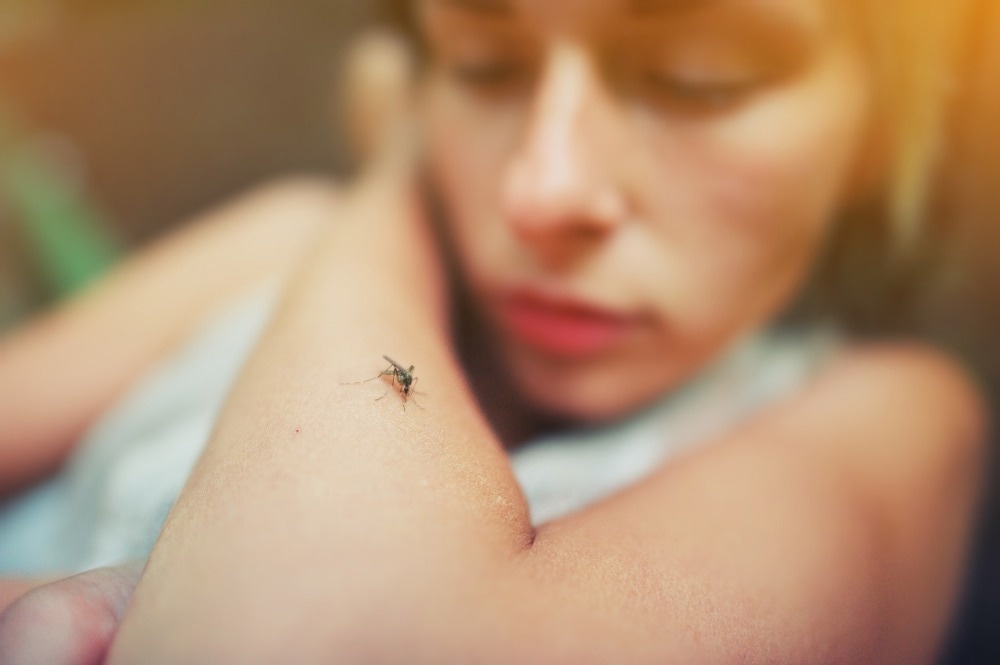In a recent review published in Cell Press, researchers explored the reasons for the greater attractiveness of some individuals to mosquitoes.
 Study: Why are some people more attractive to mosquitoes than others? Image Credit: sun ok/Shutterstock
Study: Why are some people more attractive to mosquitoes than others? Image Credit: sun ok/Shutterstock
Background
Globally, individuals are at significant morbidity and mortality risks from mosquito-borne illnesses such as malaria. Mosquito bites, although not deadly, have caused health concerns ranging from worrisome rashes to permanent complications. Healthcare authorities have developed mosquito containment strategies; however, a definite solution for threats from mosquito-borne illnesses requires deciphering the reasons for the greater attractiveness of some individuals to mosquitoes.
About the review
In the present review, researchers explored the human hunt mechanisms of mosquitoes.
Aedes aegypti, yellow fever- and dengue-transmitting mosquitoes have shown a strong intrinsic predilection for the blood of humans. The mosquito not only uses temperature and CO2 cues to hunt their warm-blooded hosts but also depends on their olfactory tissues to distinguish between volatile mixtures exuded by the host animals.
Two distinctive olfactory receptor families are responsible for human odor detection by mosquitoes, i.e., ionotropic receptors (IRs) that detect volatile acids and amines and odorant receptors (ORs) that detect hydrophobic volatile compounds such as ketones and aldehydes. The OR receptor pathway disruption does not significantly decrease the mosquito’s human hunting capability, but it attenuates the mosquito’s capability to discriminate between human beings and other mammalian species.
The ablation of IR coreceptors could impair responses to LA (lactic acid) molecules contained in human sweat and were independently inadequate for attracting mosquitoes and showed synergistic actions with carbon dioxide for robust attraction by mosquitoes. The differences in individual attractiveness to mosquitoes have been assessed robustly by the evaluation of mosquito affinity for certain individuals utilizing the individual’s upper extremities or nylon stockings that the individuals wore.
The findings have indicated that specific chemical substances exuded by cutaneous tissues enclosed in nylon stockings suffice for reproducing differential effects of attraction and indicated greater long-term (several months or years) stability of susceptibility of a few individuals to mosquito bites and mosquito-borne illnesses.
Existent mosquito strains devoid of the IR co-receptor Ir8a or the OR co-receptor Orco and the generation of novel mutant strains lacking the IR-type co-receptor molecules Ir25a or Ir76b showed that IR pathway disruptions significantly decrease human affinity to mosquitoes but retain mosquito preference for certain individuals, referred to as ‘mosquito magnets.’
On the contrary, Orco pathway disruptions showed no significant impact on the attraction of individuals to mosquitoes. Of importance, study findings have shown that neither the IR nor the OR pathway can independently discriminate between different individuals, reiterating that mosquitoes utilize redundant sensory-type pathways to make them the top predator.
Researchers have profiled carboxylic acid levels in skin odor by gas chromatography for identifying skin scent molecules linked to the differential attractiveness of individuals to mosquitoes. ‘Mosquito magnets’ exhibited elevated levels of several compounds pentadecanoic acid, nonadecanoic acid, and heptadecanoic acid.
Diluting the odor blends of highly attractive individuals by decreasing the nylon sleeve size eliminated the mosquito preferences, indicating that the dermatological tissues of the mosquito magnets or highly attractive human beings differ in the attractive odor blend levels.
Conclusions
Overall, the review findings showed that elevated levels of certain carboxylic acids such as pentadecanoic acid, nonadecanoic acid, and heptadecanoic acid were associated with greater attractiveness of individuals to mosquitoes. Mutant strains of mosquitoes with damaged OR receptors showed wild-type attraction levels, whereas mutants with damaged IR receptors were impaired to a severe extent in attraction to the human odor, but their abilities to distinguish between weakly and highly attractive individuals were retained.
The next steps in controlling mosquito-borne diseases would involve the elucidation of IR receptors and OR receptors that can identify and distinguish chemical cues from different individuals and establish the fundamental basis of affinity of certain individuals to mosquitoes for enabling receptor-based studies and identifying novel chemical modulators of mosquito mechanisms.
Further studies could be conducted to explore the manner of integration of sensory variables such as temperature, volatile scents, and carbon dioxide levels into the brain of mosquitoes and alterations in human host-hunting behavior based on environmental alterations or genomic ablation of particular sensory pathways.
The human host preference of the Ae. aegypti species of mosquitoes evolved parallelly with that of other genetically distant species of mosquitos, such as the anopheline species. Research could be conducted to improve understanding of the convergent pathways used by several organisms for specializing in the slender recess of biting human beings.